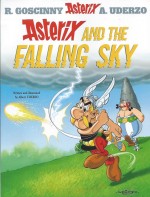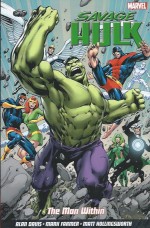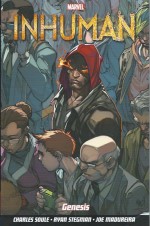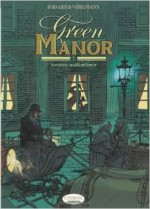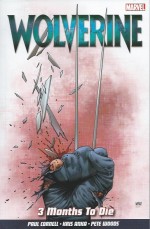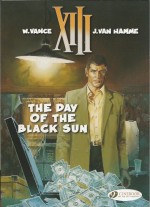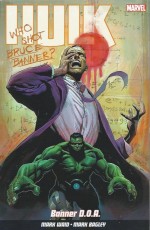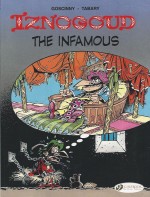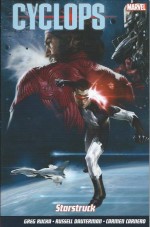
By Greg Rucka, Russell Dauterman, Carmen Carnero, Terry Pallot & various (Marvel/Panini UK)
ISBN: 978-1-84653-624-3
When mutant genius Henry McCoy learned he was dying, he used time-travel tech in a last-ditch attempt to give his life meaning. Seeking to prevent a species war, he brought the young, naive X-Men of his own youth into the future to reason with his radicalised former comrade Scott Summers, praying the still idealistic and hopeful teens could divert Mutant Enemy Terrorist No. 1 from his path of doctrinaire madness…
The gamble paid off in all the wrong ways. Rather than shocking Cyclops back to his senses, the confrontation hardened the renegade’s heart and strengthened his resolve. Moreover, after the younger McCoy miraculously cured his older self, he and the rest of the X-Kids were trapped in their own future and began gradually defecting to the fundamentalist team…
Eventually the temporally misplaced First Class all ended up living with the elder Cyclops’ crew, but everything changed after Gladiator of the Shi’ar realised that Jean Grey AKA Marvel Girl – and future host of the cosmic force known as the Phoenix – was back. The alien overlord rashly attempted to abduct and execute her for the crimes of her older self…
The insane pre-emptive punishment plan was foiled by an amalgamation of X-Men, Guardians of the Galaxy and intergalactic buccaneers Hepzibah, Ch’od, Raza and bizarre medical wizard Sikorsky – collectively known as The Starjammers.
During the cosmic conflict 16-year-old Scott met his believed-dead dad Christopher, now called Corsair and undisputed leader of the cosmic privateers and, when the mutant heroes returned to Earth, he chose to remain in space with the father he had spent most of his brief life assuming killed in a plane crash…
Scripted by Greg Rucka and illustrated by Russell Dauterman, Carmen Carnero & Terry Pallot, stellar saga Starstruck collects issues #1-5 of Cyclops: (July-November 2014), following the chronal castaway to the ends of the universe and even further into uncharted emotional territory…
The story begins as the still shell-shocked teen spends some time in hard vacuum with his dad’s exotic paramour Hepzibah. Together they are testing his new spacesuit which allows him to fire his fearsome optic blasts safely through his helmet. That and reminiscing about how he got here and revelling in the sheer majesty of the intergalactic firmament, of course…
For most of his comicbook career Scott Summers has been capable and competent but also dour, grim, despondent and simply no fun at all. Here, however, we get to see the incredible hero he always was, but also follow a nervous, unsure kid hungry for affirmation and still capable of ingenuous wide-eyed wonder.
That’s never more ably demonstrated than when his attempts to write a letter to Jean (the girl everybody from the future tells him he will marry and lose) are interrupted by an attack on the starship.
The Starjammers are wanted by almost every empire in the universe but this ambush by the scurrilous Brotherhood of Badoon is easily repulsed and only results in the pirates capturing their attackers’ vessel primarily intact…
Not so easily handled is the growing gulf between Scott and Corsair. The boy simply cannot accept why his father would allow him – and indeed his future self – to believe he was dead for decades…
The grizzled star-pirate thinks he has a solution. Giving Scott a sword liberated from the vessel (apparently a crucial piece of kit for any space-farer regularly indulging in close combat) Christopher Summers suggests a father-and-son vacation: a few months tooling around the galaxies in their newest prize, just getting to know each other…
At first the grand tour is all mind-bending exploration and eye-popping alien encounters but eventually Scott begins to see a disturbing pattern to his dad’s actions and comes to a horrifying conclusion. Corsair is a drug addict and their numerous stopovers in quirky cosmic bazaars and seamy sidereal marketplaces are simply opportunities to restock his personal pharmacopoeia…
One such jaunt introduces the boy to unlikely barkeeper and crimelord Baroque and leads Scott into a potentially life-changing VR encounter with a svelte and sexy alien temptress named Vass. Unfortunately anything he might have learned is promptly forgotten when a multi-species band of merciless bounty hunters corners the father and son team.
The wily thief-takers are utterly unprepared for Cyclops’ optic blasts however and the displaced humans get away relatively unscathed… except for Corsair’s fresh stash of drugs…
The next crisis occurs soon after as the Badoon ship catastrophically malfunctions and shipwrecks them on an isolated planetoid. Painfully scouring through the wreckage some time later, Scott discovers a tracking device – now destroyed – and finally confronts his father about the drugs.
He is doubly appalled when Corsair shamefully reveals that rather than buying narcotics, his dad has been visiting every criminal dive in creation “scoring†proscribed nanite technology: the only thing currently keeping him alive…
Stranded on a primitive mudball filled with predators all becoming increasingly less cautious and more hungrily curious, Scott at last learns of his unsuspected brother Vulcan, a mutant who once seized control of the Shi’ar Empire, sparked an intergalactic war and killed their father…
Of course, his devoted comrades refused to leave Corsair dead and petitioned the enigmatic creatures known as the Shrouded to restore him. The cloaked wonders succeeded but the cure requires constant and illicit maintenance…
Days pass and as the last dregs of the contraband drugs are used up, fading father and son grow closer, even to the point where they unite to turn the tables on the horrific bird-things stalking them.
As Corsair impatiently tries to teach his son everything he’ll need to know to survive the decades he might be alone on the planetoid, the boy derives a desperate scheme to save them both. The first step is to repair the tracking device and lure the certainly still interested bounty hunters to their current location…
Everything goes according to plan and the hunters become the hunted, but at the critical moment Scott, seemingly swayed by the blandishments of the mercenaries’ female slave, sells his own dad out…
What happens next proves the boy hero’s astonishing tactical genius and saves everyone’s lives – if not necessarily their honour…
Heartwarming, thrilling, funny and astoundingly action-packed, Starstruck combines cosmic intrigue and dashing derring-do with solid characterisation and wild blue yonder wonderment, and comes with a covers-&-variants gallery by Alexander Lozano, Greg Land, John Tyler Christopher and Paul Renaud as well as AR icon sections (Marvel Augmented Reality App) for access to story bonuses once you download the free code from marvel.com onto your smart-phone or Android-enabled tablet.
What more could any wide-eyed, entertainment-starved child of the wondering stars want?
™ & © 2014 Marvel & Subs. Licensed by Marvel Characters B.V. through Panini S.p.A. All rights reserved. A British Edition published by Panini Publishing, a division of Panini UK, Ltd.

